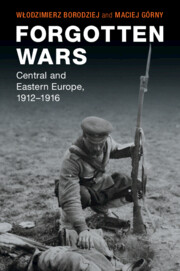Refine search
Actions for selected content:
15401 results in Military history
Part I - The Fronts
-
- Book:
- Forgotten Wars
- Published online:
- 15 March 2021
- Print publication:
- 01 April 2021, pp 11-158
-
- Chapter
- Export citation
Select Bibliography
-
- Book:
- Forgotten Wars
- Published online:
- 15 March 2021
- Print publication:
- 01 April 2021, pp 352-364
-
- Chapter
- Export citation
8 - The First Moments
- from Part III - Occupation
-
- Book:
- Forgotten Wars
- Published online:
- 15 March 2021
- Print publication:
- 01 April 2021, pp 245-285
-
- Chapter
- Export citation
7 - Loyalties
- from Part II - The Rear
-
- Book:
- Forgotten Wars
- Published online:
- 15 March 2021
- Print publication:
- 01 April 2021, pp 219-242
-
- Chapter
- Export citation
10 - Mission civilisatrice
- from Part III - Occupation
-
- Book:
- Forgotten Wars
- Published online:
- 15 March 2021
- Print publication:
- 01 April 2021, pp 314-348
-
- Chapter
- Export citation
9 - New Orders
- from Part III - Occupation
-
- Book:
- Forgotten Wars
- Published online:
- 15 March 2021
- Print publication:
- 01 April 2021, pp 286-313
-
- Chapter
- Export citation
Contents
-
- Book:
- Forgotten Wars
- Published online:
- 15 March 2021
- Print publication:
- 01 April 2021, pp v-v
-
- Chapter
- Export citation
Part II - The Rear
-
- Book:
- Forgotten Wars
- Published online:
- 15 March 2021
- Print publication:
- 01 April 2021, pp 159-242
-
- Chapter
- Export citation
Capsules
-
- Book:
- Forgotten Wars
- Published online:
- 15 March 2021
- Print publication:
- 01 April 2021, pp x-x
-
- Chapter
- Export citation
Maps
-
- Book:
- Forgotten Wars
- Published online:
- 15 March 2021
- Print publication:
- 01 April 2021, pp ix-ix
-
- Chapter
- Export citation
3 - Before the Leaves Fall from the Trees …
- from Part I - The Fronts
-
- Book:
- Forgotten Wars
- Published online:
- 15 March 2021
- Print publication:
- 01 April 2021, pp 61-137
-
- Chapter
- Export citation
2 - Prelude: The Balkans 1912–1913
- from Part I - The Fronts
-
- Book:
- Forgotten Wars
- Published online:
- 15 March 2021
- Print publication:
- 01 April 2021, pp 36-60
-
- Chapter
- Export citation

Forgotten Wars
- Central and Eastern Europe, 1912–1916
-
- Published online:
- 15 March 2021
- Print publication:
- 01 April 2021
4 - The context: From Regime Change, to Peace Building, to Countering Insurgents: Stabilising Afghanistan
-
- Book:
- Inescapable Entrapments?
- Published by:
- Amsterdam University Press
- Published online:
- 18 December 2024
- Print publication:
- 04 March 2021, pp 61-70
-
- Chapter
- Export citation
Contents
-
- Book:
- Islands of Memory
- Published by:
- Jagiellonian University Press
- Published online:
- 15 July 2022
- Print publication:
- 04 March 2021, pp 7-10
-
- Chapter
- Export citation
Bibliography
-
- Book:
- Inescapable Entrapments?
- Published by:
- Amsterdam University Press
- Published online:
- 18 December 2024
- Print publication:
- 04 March 2021, pp 201-228
-
- Chapter
- Export citation
6 - Case Study: The Decision Path to Helmand
-
- Book:
- Inescapable Entrapments?
- Published by:
- Amsterdam University Press
- Published online:
- 18 December 2024
- Print publication:
- 04 March 2021, pp 117-154
-
- Chapter
- Export citation
History and Expectations of the Project
-
- Book:
- Islands of Memory
- Published by:
- Jagiellonian University Press
- Published online:
- 15 July 2022
- Print publication:
- 04 March 2021, pp 23-26
-
- Chapter
- Export citation
2 - Civil-Military Decision-makers within Their Theoretical Context
-
- Book:
- Inescapable Entrapments?
- Published by:
- Amsterdam University Press
- Published online:
- 18 December 2024
- Print publication:
- 04 March 2021, pp 31-48
-
- Chapter
- Export citation
Part 1 - Memory
-
- Book:
- Islands of Memory
- Published by:
- Jagiellonian University Press
- Published online:
- 15 July 2022
- Print publication:
- 04 March 2021, pp 27-186
-
- Chapter
- Export citation
